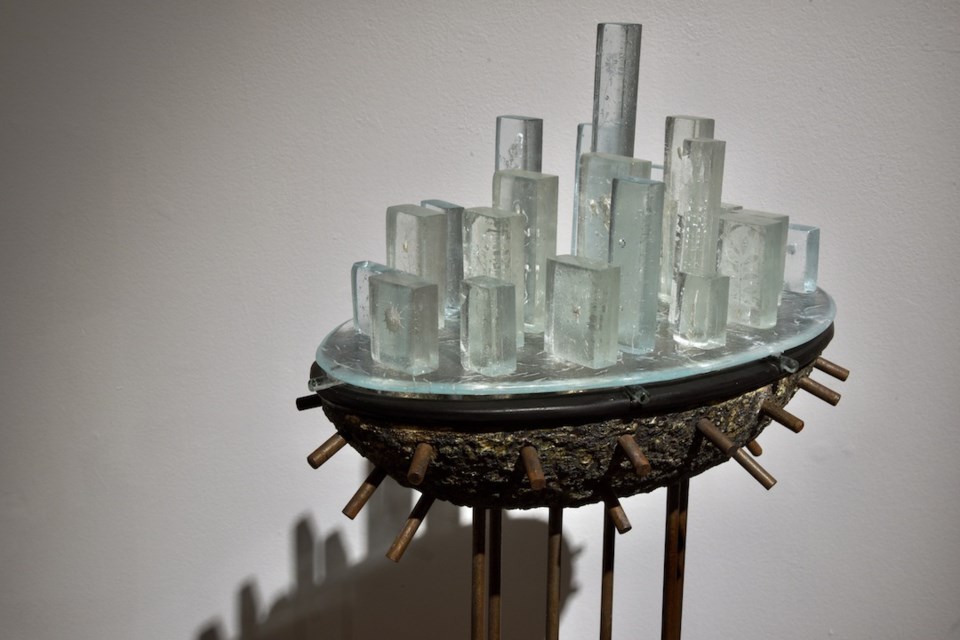The latest show at the Godfrey Dean Art Gallery is Passages. A collaboration between glass artist Louisa Ferguson and ceramic artist Paula Cooley, the new show mixes their two disciplines with a new one for both, metal.
The collaboration started in 2015 after Ferguson and Cooley partnered together in a mentorship program offered by CARFAC Saskatchewan. Artists are matched together, and given 10 months to work together. They started collaborating then, and decided to continue working together, and were getting interesting pieces and ideas, said Cooley.
“We wanted to pursue it further. Because, in some ways, deadlines are a good thing and make you work, we decided to apply for a two-person show at the Saskatchewan Craft Council gallery that would feature our collaborative works. We were lucky enough to get that exhibition, and that is what you are seeing at the Godfrey Dean now,” said Cooley.
One of the defining feature of the show is the form of a boat, which Ferguson described as a vessel which could carry metaphors.
One example is a piece, called Casten, which has a clay boat shape with spikes, carrying glass blocks with the impression of natural flora cast in them.
“When I was building that ceramic metal base, I was thinking of Louisa’s beautiful, delicate glass shafts, with these gorgeous delicate imprints. I was thinking about the vessel protecting that. It was the idea that you can’t get too close, because the boat is acting as a protector. To me, it was the idea of working with something that attracts you, makes you want to move in closer, but then you go ‘oh, this could make me bleed!’” said Cooley.
“I collect natural flora from the area around where I live, and I actually put it in the kiln with the glass. So what you actually see is the ghosting of those images. The white part is actually the ash of those flowers and leaves which leave a residue on the glass. For me, that piece is very much about the things that we are losing in our natural environment,” Ferguson added.
Clay and glass might be different in look, but they come from the same place.
“They come from the same place, but they have very different characteristics. Ceramics, unless you’re dealing with very fine, very translucent porcelain, doesn’t really let light through, while glass does. However, glass is incredibly solid, but it doesn’t feel solid the way ceramic does because it lets through. There are these two materials that play with different things in different ways but come from the same place.”
To add extra challenge, they also learned how to manipulate metal for the work. They worked with blacksmith M. Craig Campbell to learn how, who was their mentor. One connection between each material is metal, ceramic and glass all need fire to work - “we’re pyromaniacs!” joked Ferguson.
The mentorship really worked because of how much they wanted to see the other’s medium influence their own.
“For me, I was really interested in how my ceramic forms could be mated with glass, but I don’t have any technical ability with glass, whereas Louisa did. So I really appreciated that opportunity to try some new things technically. I also appreciated working with another artist who had a different aesthetic. I think, because we had worked together previously in the mentorship, we had an idea of where we were coming from. We didn’t want to be doing identical work, but work that made sense together,” said Cooley.
“Paula was very interested in glass, so there was a lot of glass skill I could impart to her, and I was – and still am – very interested in ceramics, so there was information she could give to me. It was a very symbiotic educational thing.”
There is a fourth material, with light playing a role in each piece. Cooley said one of the things she is interested in is taking a solid material like clay and making it as transparent as possible, and Ferguson added that in installing the show, they worked hard to make sure it was lit in order to add shadows to the work itself. Both artists would like to thank Godfrey Dean Gallery Manager Kelly Litzenberger for his help lighting the show.
“He did a really great job of lighting the work, and the light really animates them,” said Cooley.
“That’s actually quite rare when you go into a gallery. Number one, that they have proper lights, good lights, enough lights in the right spot. All of those things. And then, also, to have somebody on staff who knows how to manipulate lights and understands, that was amazing. When you think of a show like Passages, everything depends on that. We’re talking about passage, light through objects. We’re actually really pleased with the installation at the Godfrey Dean.”
More than just a melding of forms, the show was also a true collaboration between different artists with different points of view.
“The one thing that supersedes everything is that Paula and I approach the act of making in the same way. We really believe it is a dialog. Even if I’m working on my own, I’m really having a dialog with the material that I’m working with,” said Ferguson.
“When we worked together, it was really easy for us to have a collaborative, creative dialog between each other, which actually made it very freeing. It allowed us to go, as individual artists, to places we normally wouldn’t have gone, because we had this influence of someone else.”
“We would both bring ideas to the table and work through. I wouldn’t show up with a sketch and say ‘Louisa I need you to make this,’ it was more, ‘this is what I’m thinking, what do you think Louisa?’ For both of us, I think we made forms that surprised us, that we didn’t expect, that we developed because of that dialogue,” added Cooley.




